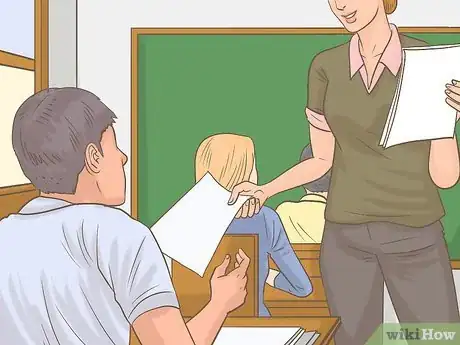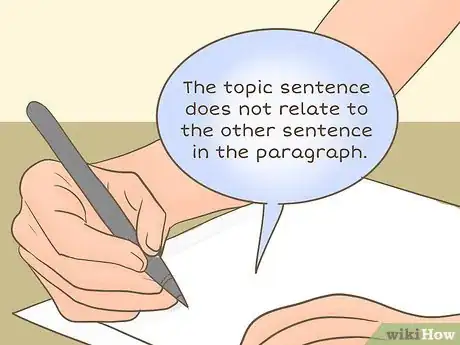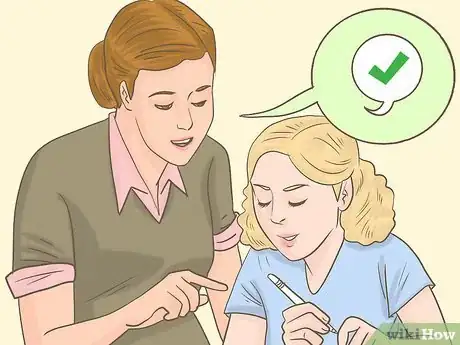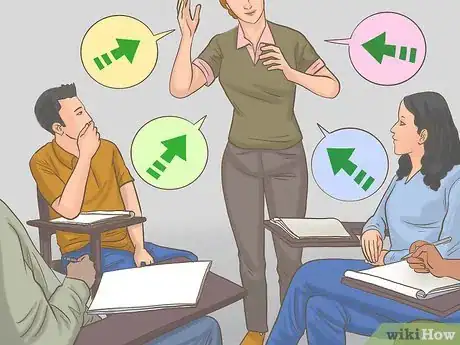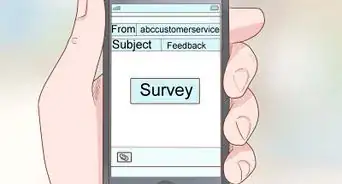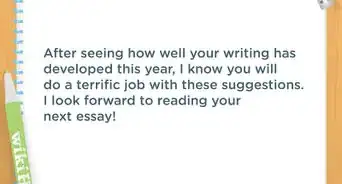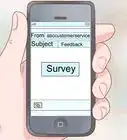This article was co-authored by Christopher Taylor, PhD. Christopher Taylor is an Adjunct Assistant Professor of English at Austin Community College in Texas. He received his PhD in English Literature and Medieval Studies from the University of Texas at Austin in 2014.
This article has been viewed 35,730 times.
Feedback is one of the best ways to help students learn. Even if you’re a veteran teacher, you might be looking for ways to make your feedback more effective. There are ways to do this for students of all ages, no matter what subject you teach. You can use a lot of the same techniques for both verbal and written feedback. For example, it should always be timely and constructive. You can tailor your feedback to help students achieve their goals, which will make you an even better educator!
Steps
Providing Helpful Written Feedback
-
1Return assignments promptly so that students can implement feedback. Give students their graded assignments as soon as you can compose your feedback. This will ensure that the assignment is still fresh in their mind. Prompt feedback is likely to make more of an impact than feedback that is submitted long after the assignment was due.[1]
- How quickly you can provide feedback will vary on the assignment and how many students you have. For short assignments, try to provide feedback in a day or 2. If it is a longer paper, a week is considered appropriate.
- If you have a large class, start grading early and break your grading into pieces. Don’t try to sit down and grade 70 papers at once! You’ll likely lose your concentration (or patience) and your feedback won’t be as effective. Start working on grading right after you get your students’ assignments, but only do a little at a time.
-
2Write for the level of the individual student. Make sure that the student can understand your comments by tailoring them to the individual. For example, if you are teaching an introduction to business class, don’t assume that students are experts in the field. Avoid using jargon or terms that they haven’t learned yet.[2]
- Make sure that the comments are appropriate for the grade level. For a 5th grader, write something like, “You’ve done a great job clearly labeling your posters for your science project. In the future, I’d like you to work on writing in complete sentences. For example, instead of "More recycling," you could write, "If more people recycle, the planet will be in better shape.” For a senior in high school, you could write, “You’ve clearly stated your thesis. However, you need to cite the sources you’ve used to support your argument. Please search online for Chicago Manual of Style guidelines. Let me know if you need help formatting footnotes.”
- If English is not the student’s first language, you might need to use a more basic vocabulary than you otherwise would.
Advertisement -
3Start with positive comments to encourage students. Offer some praise or encouragement at the beginning of your feedback. If you start on a negative note, students might get discouraged and not finish reading your comments. Also, find something positive about the student’s work to help make your feedback sound constructive.[3]
- You could write, “This is a real improvement from your last test! I can tell you spent a lot of time reviewing the information.”
- Try something like, "The example about your grandmother in the introduction really personalizes your story. Great job!"
-
4Be concise and direct to avoid overwhelming students. Write feedback that is clear and to the point. Instead of writing several sentences, try using bullet points and write no more than 1 or 2 sentences per point. Students might find that style easier to understand. Try writing points like:[4]
- "Great example in your introduction."
- "Make sure thesis is in intro., not later in the paper."
- Start by talking about the origins of the Civil War in your first paragraph."
- "Use more than 1 example to illustrate your point."
- "Good improvement from last assignment."
-
5Use specific examples to help students understand your point. Avoid vague statements like “Interesting!” or “Good job!” Instead, clarify what exactly you are commenting on. Point to a specific example in the assignment to make your point clear.[5]
- You could note, “The topic sentence does not relate to the other sentence in the paragraph. Try writing more sentences about the main topic, which is how to recycle at home.”
Offering Useful Verbal Feedback
-
1Use oral feedback if it is extensive or if the student doesn’t read well. Verbal feedback is effective because you can explain exactly what you mean to your students. If you need to give extensive feedback, do so face-to-face. This will help the student connect with what you’re saying, and help them to not feel overwhelmed.[6]
- Try verbal feedback with younger students or students who have trouble retaining written information. That way, you can answer any questions immediately.
- Stick to a few key points so that students don't become overwhelmed. You can always schedule another meeting if you need to go over additional information.
-
2Provide students with verbal feedback as soon as possible so they remain engaged. Don’t wait several days or even weeks to talk to your students. Instead, ask them to talk to you as soon as you return the assignment. If you teach college, invite the student to your office hours.[7]
- If you teach younger students, ask them to hang back before going to lunch or to visit your classroom before or after school.
-
3Try to give verbal feedback in a one-on-one setting for privacy. Respect your students’ privacy by choosing a quiet space for feedback. You don’t want them to feel embarrassed if you need to give them some constructive criticism.[8]
- Ask the student to meet with you after class, or come in early the next day.
- If possible, try to meet individually with each of your students to discuss their progress on a major assignment. This will give the student a chance to ask questions. You can also use this opportunity to identify any issues the student might be having and offer details about your expectations.
-
4Smile as you speak to encourage students. Your face can be very expressive. A smile can help put students at ease. Take note of your facial expressions when giving feedback so that you don’t convey negativity. Don’t frown at the student, even if you’re frustrated with their performance.[9]
- You can also nod to show your encouragement.
-
5Ask the student to take notes to help retain feedback. If you are giving a lot of feedback, suggest that the student jot down your main points. That way, they can refer back to the feedback at a later time. This will help them apply your comments to future assignments.[10]
- You can also write down your main points and then go over them together in your individual meeting.
Helping Students Improve through Feedback
-
1Make feedback ongoing so that students can implement it. Follow up with students to make sure that they are applying your feedback. For example, if you told them to use better sources, check in with them before the next paper is due.[11]
- You could say, “I wanted to make sure you understood what I said about better source use. Here's an article about how to identify good online sources. Please look this over and let me know if you have questions.”
-
2Focus on building key skills to make feedback more applicable. It’s tempting to nitpick over small errors. However, you can help your students more by working on big issues first. You can go back and fix small issues later.[12]
- For example, maybe your student has a poorly written book report. Instead of focusing first on poor grammar, help your student learn to more clearly express their ideas and organize their thoughts.
-
3Allow students to respond to feedback to feel involved. Let your students know that you are happy to answer any questions that they have. Announce to the class that you are willing to answer general questions. You can also tell your students that you’re happy to talk to them individually about the feedback.[13]
- You could say, "Does anyone have questions about the criteria I used to grade these papers? I'm happy to explain further. I'm also available to talk to you after class."
-
4Provide students with resources to help them improve. Sometimes students might need more help than you can give them. If a student is really struggling, direct them to someone else who can help, too. If a student suffers from test anxiety, encourage them to visit the school counselor.[14]
- If a student needs a lot of extra help, see if you can arrange for them to have a tutor.
References
- ↑ https://blogs.kcl.ac.uk/aflkings/rich-in-formal-feedback/giving-effective-written-feedback/how-can-i-give-effective-written-feedback/
- ↑ https://blogs.kcl.ac.uk/aflkings/rich-in-formal-feedback/giving-effective-written-feedback/how-can-i-give-effective-written-feedback/
- ↑ https://teachingcenter.wustl.edu/resources/writing-assignments-feedback/commenting-on-student-writing/
- ↑ https://blogs.kcl.ac.uk/aflkings/rich-in-formal-feedback/giving-effective-written-feedback/how-can-i-give-effective-written-feedback/
- ↑ https://cirt.gcu.edu/teaching/tips/effectivefeed
- ↑ https://cirt.gcu.edu/teaching/tips/effectivefeed
- ↑ https://cirt.gcu.edu/teaching/tips/effectivefeed
- ↑ https://www.teachthought.com/pedagogy/20-ways-to-provide-effective-feedback-for-learning/
- ↑ https://www.teachthought.com/pedagogy/20-ways-to-provide-effective-feedback-for-learning/
- ↑ https://www.teachthought.com/pedagogy/20-ways-to-provide-effective-feedback-for-learning/
- ↑ http://www.ascd.org/publications/educational-leadership/sept12/vol70/num01/Seven-Keys-to-Effective-Feedback.aspx
- ↑ https://blogs.kcl.ac.uk/aflkings/rich-in-formal-feedback/giving-effective-written-feedback/how-can-i-give-effective-written-feedback/
- ↑ https://blogs.kcl.ac.uk/aflkings/rich-in-formal-feedback/giving-effective-written-feedback/how-can-i-give-effective-written-feedback/
- ↑ https://blogs.kcl.ac.uk/aflkings/rich-in-formal-feedback/giving-effective-written-feedback/how-can-i-give-effective-written-feedback/
